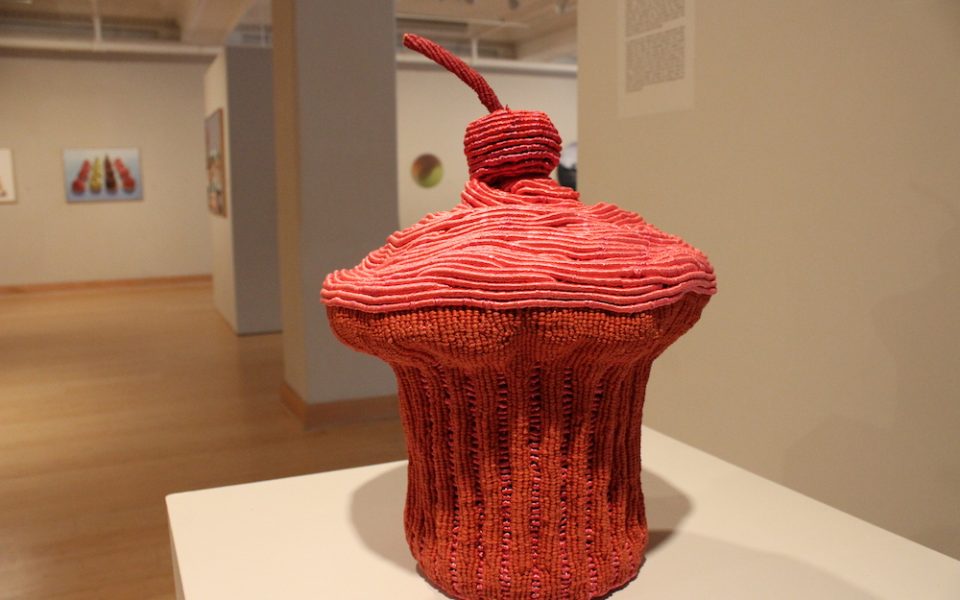Crystalline orange granules interrupt thin concentric rings of white that border the circular canvas. Delicate bubbles form on shades of orange, starting as a saturated clementine, then blend into a bright, neon amber as the observer’s eye moves from top to bottom.
A glance at the work’s description reveals that the large, blown-up photograph by Durham artist Kristen Baumlier-Faber, is titled “Tang,” and is an up-close portrait of the brand-name orange drink mix that was popularized in the ’60s after NASA astronauts like John Glenn consumed it in space. The piece is part of Sweet, a new eight-artist exhibition on display at the Greenhill Center for North Carolina Art in downtown Greensboro that portrays food as art.

“You get the experience of the food but… you try and figure it out, like what exactly it is,” explains Edie Carpenter, the direct of artistic and curatorial programs for Greenhill. “You have this kind of wonderful texture of the bubbly.”
The photo is part of a series of works that Baumlier-Faber calls Bliss, which is inspired by Michael Moss’s 2013 bestselling book, Salt, Sugar, Fat, which uncovered the ways that food corporations make their product irresistible to consumers.
Nearby, a row of three large, clear bowls are filled to the brim with Tang drink, Doritos chips and cheese balls. Each has a corresponding photograph behind it that captures the food on a molecular level. And while it’s tempting to eat the food — Carpenter says that some people have been snacking on the pieces — that’s not the point.
“I think she wants people to see them,” she says. “Actually look at them. Because when you consume them in the bag, you don’t see what they are.”
Carpenter says that she had been wanting to do a multisensory exhibition for a while (there’s a table of provided snacks in the gallery) and landed on the idea of sweet foods because of the universality of the taste.
“There’s a whole tradition and there’s a whole art of baking and homemade sweets,” Carpenter says. “As soon as [sugar] became available in the 16th Century, it’s had this exponential rise in market value and it’s the one food that universally has increased in terms of demand.”
Towards the entrance of the exhibit, a row of beautifully rendered watercolor paintings of creatures grace the wall. A fierce and majestic tiger peers out of its frame next to a regal vampire while a group of white rabbits huddle together on an opposite wall.
In front of each painting sits a bowl of cereal that corresponds with its mascot.
On the wall, artist Jillian Ohl describes her series of paintings, Sugar Coated, as a way of portraying popular children’s cereal mascots “in a dignified manner without exploiting them for their fame or notoriety.”
Around the corner, New York-based artist Robin Frohardt’s cakes draw attendees in with realistic frosting and vibrant fondant. In reality, most of her works are created with cardboard and plastic bags. An excerpt from her larger 2016 installation, Plastic Bag Store, in which Frohardt created an entire storefront with consumer goods molded from plastic bags, the pieces aim to show the detrimental impact of human consumption and waste on the environment.
-

Jillian Ohl’s Sugar Coated series portrays popular children’s cereal mascots “in a dignified manner without exploiting them for their fame or notoriety.” -

Artist Stacy Crabill uses mixed media to portray human figures with sweets and a little fortune cookie slip. (photo by Sayaka Matsuoka) -

Robin Frohardt’s cakes are an excerpt from her larger 2016 installation, Plastic Bag Store, in which she created an entire storefront with consumer goods molded from plastic bags. (photo by Sayaka Matsuoka)
“It’s a real critique of the horrible impact of plastic on the environment that we’re learning more and more about,” Carpenter explains.
Filling out the rest of the gallery are works that continue to touch on the overwhelming allure of sweets and how they affect people’s lives.
Artist Bethany Pierce’s dramatic vanitas paintings depict decadent cakes that look like as if they are melting before the viewer’s eyes while Rachel Campbell’s paintings take ordinary snacks like Krispy Kreme donuts and M&M vending machines to create large, vibrant snapshots. Three-dimensional works like Ed Bing Lee’s fiber sculptures of cupcakes and an ice-cream cone offer a more tangible experience while Paul Rousso’s acrylic, blown-up installations of popular candy wrappers immortalize the disposable packaging that consumers take for granted.
-

Rachel Campbell takes everyday sweets and elevates them with her colorful palate and intricate detail. (photo by Sayaka Matsuoka) -

Rachel Campbell takes everyday sweets and elevates them with her colorful palate and intricate detail. (photo by Sayaka Matsuoka)
Perfect for the summer and at first glance an easily digestible show, “Sweet” challenges viewers in more ways than one, pitting consumer against producer, personal desires against self-control, and companies against the environment.
“It’s so universally experienced by everyone,” Carpenter says. “I think everyone to a certain degree has some sort of a sweet tooth.”
Sweet will be on display at Greenhill through July 14. On Friday, June 7, the gallery will host an artist-led tour of the exhibit starting at 6 p.m. Visit Greenhill’s website for additional programs and events.
Join the First Amendment Society, a membership that goes directly to funding TCB‘s newsroom.
We believe that reporting can save the world.
The TCB First Amendment Society recognizes the vital role of a free, unfettered press with a bundling of local experiences designed to build community, and unique engagements with our newsroom that will help you understand, and shape, local journalism’s critical role in uplifting the people in our cities.
All revenue goes directly into the newsroom as reporters’ salaries and freelance commissions.


Leave a Reply